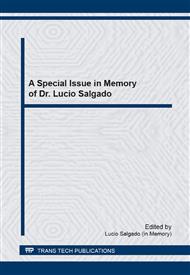p.71
p.77
p.83
p.89
p.94
p.100
p.106
p.111
p.116
Nanoferrites Ni-Zn Silanized with 3-Aminopropyltrimethoxysilane Using the Reflux Method
Abstract:
In this paper we propose nanoferrites Ni-Zn silanization with 3-aminopropyltrimethoxysilane using the method of reflux and evaluate the effect of silanization on the structure, morphology and magnetism of the magnetic nanoparticles aimed at biological applications. The samples as synthesized and after silanization were characterized by XRD, FTIR, SEM and testing magnetic attraction. The results indicated a single phase inverse spinel Ni-Zn ferrite, high intensity of diffraction peaks and a high basal width of all reflections observed, indicating that the samples are crystalline, and formation of nanoparticles. Morphologically, for nanoferrites Ni-Zn synthesized observed formation of large agglomerates in the form of spongy blocks of frail and after silanization was observed with respect dense pellets, indicating that most particles were rigidly connected by the presence of the agent silane. The characteristic bands of the spinel were observed for the Ni-Zn nanoferrites before and after silanization, and also observed the characteristic bands of silane in confirming the ferrites silanized functionalization of ferrites with the silane agent. Nanoparticles ferrite as synthesized and after silanized were strongly attracted by the presence of a magnet, immediately after the presence thereof indicating that the silane is effective is not interfere with the magnetic particles, maintaining the same magnetic behavior.
Info:
Periodical:
Pages:
94-99
Citation:
Online since:
September 2014
Authors:
Keywords:
Price:
Сopyright:
© 2015 Trans Tech Publications Ltd. All Rights Reserved
Share:
Citation:


